
Airfix 1/72 Buccaneer S.1
| KIT #: | ? |
| PRICE: | ? |
| DECALS: | ? |
| REVIEWER: | Carmel J. Attard |
| NOTES: | A rather complete upgrade of an ancient kit. |

| HISTORY |
Hal-Far airfield has always been a
busy airfield with Fleet Air Arm exercises simulating combat between Seahawks,
Avengers, Wyverns, Skyraiders, Meteors and Shackletons the latter pretending to
be heavy bombers. Those who lived in areas around Zurrieq and Qrendi enjoyed the
delight of witnessing dive-bombing on the 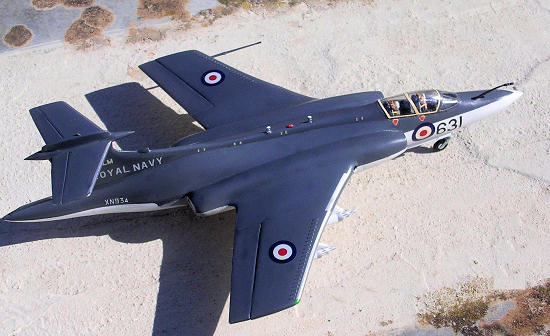 the area
rule bulged fuselage and the split air brake concept. This contained strakes
above and below the air brake
which varied in size difference until
a suitable configuration
was finally
adopted.
the area
rule bulged fuselage and the split air brake concept. This contained strakes
above and below the air brake
which varied in size difference until
a suitable configuration
was finally
adopted.
Buccaneer XP490 was also on
display at Le Bourget Air show in June 1959 at a time when the overall
dimensions were finally released to a none-too-surprised world. It also took
part in the September 1959 Farnborough air show where it flew from Boscombe Down
each day to keep it away from preying eyes as it was the only major new type
present and therefore generated great interest. The month following the show
XK490 became the first NA39 to be lost on 12.10.59 while it was on an evaluation
flight from Boscombe Down with an American pilot and a
The
loss and subsequent investigations delayed carrier trials. The Buccaneer as it
came to be known carried out its first carrier deck landings in January 1960.
XK523 was the first to land on a carrier, HMS Victorious.
The production aircraft were
designated S.Mk1, the ‘S’ indicating strike i.e. nuclear capability. One of the
Squadrons equipped with the S.Mk1 was No 809. This squadron besides continuing
trial work did embark aircraft on board Royal Navy carriers. 809’s principal
task was to train pilots and observers for front-line Buccaneer squadrons. The
activity continued until
An important element in the early
days of the Navy Buccaneer operations was provision of in-flight refuelling.
Owing to the low thrust of the Gyron Junior engines the S.Mk1 struggled to get
airborne from carrier decks with full fuel and weapon load. Aircraft were
launched with reduced fuel and then topped up by a Scimitar F.Mk1 tanker. They
performed sterling service in support of
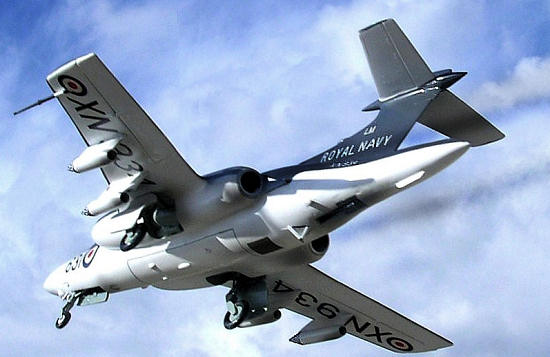 Buccaneers
during the 1965/66 Beira patrol, keeping very close eye on shipping in the
vicinity of the port of Beira, which was the coastal terminal of oil pipeline to
Rhodesia. Patrol by Buccaneers was from dawn to dusk tasked with ship plots and
tanker reconnaissance. Due to lack of diversion airfields air to air refuelling
was extensively used from Scimitar and Sea Vixen tankers.
Buccaneers
during the 1965/66 Beira patrol, keeping very close eye on shipping in the
vicinity of the port of Beira, which was the coastal terminal of oil pipeline to
Rhodesia. Patrol by Buccaneers was from dawn to dusk tasked with ship plots and
tanker reconnaissance. Due to lack of diversion airfields air to air refuelling
was extensively used from Scimitar and Sea Vixen tankers.
The S.Mk1 was undoubtedly
successful with its role but was generally agreed underpowered. During its time
the S.Mk1 had given the FAA a potent low-level attack aircraft which had quickly
supplanted the ScimitarF.Mk1 in the strike (nuclear) and attack (conventional)
roles. The resultant comfort factor enabled S.Mk1 crews to make longer low-level
target approaches with less fatigue, which resulted in more accurate, survivable
attacks. The S.Mk1 was good and it passed the way for a much more effective
S.Mk2 which therefore had a smoother entry into operational service powered by
more powerful Spey engines.
| THE KIT |
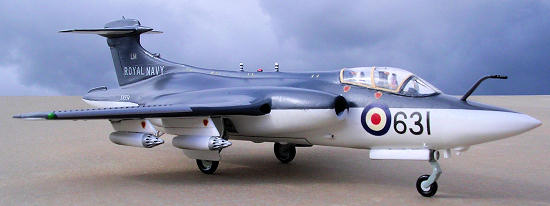
| CONSTRUCTION |
Designed with a strong airframe
the Buccaneer was powered by two DH Gnome engines and with avionics fit
continually updated with latest progress. The work involved to bring the NA39
model to an S.Mk1 standard is evident but for the modeller this was not a
complex update and appeared to be within the scope of the average modeller.
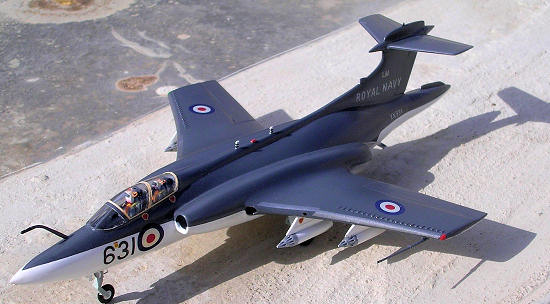 After
cleaning the kit parts when detached from the sprues the first job was to
assemble the movable bomb bay door to a static position, as this was a gadget
that I could do without for the sake of accuracy. The undercarriage well needed
to be built up to simulate side of engines and to include spar construction
forming part of the u/c bay internal detail. Rectangular pieces of plastic card
were cut to form the fuselage and bay side bulkheads. I drilled a hole in the
main undercarriage upper wing construction each to take the wheel leg. The two
wing root air intakes also needed blanking pieces on the inside. These were
added from scrap plastic card and painted black. A nose wheel well box was also
built up from plastic card so that cockpit sits directly on it. A shallower box
was built for the arrestor hook. These had the doors removed.
After
cleaning the kit parts when detached from the sprues the first job was to
assemble the movable bomb bay door to a static position, as this was a gadget
that I could do without for the sake of accuracy. The undercarriage well needed
to be built up to simulate side of engines and to include spar construction
forming part of the u/c bay internal detail. Rectangular pieces of plastic card
were cut to form the fuselage and bay side bulkheads. I drilled a hole in the
main undercarriage upper wing construction each to take the wheel leg. The two
wing root air intakes also needed blanking pieces on the inside. These were
added from scrap plastic card and painted black. A nose wheel well box was also
built up from plastic card so that cockpit sits directly on it. A shallower box
was built for the arrestor hook. These had the doors removed.
I added lead weight to the nose
cone, which was blanked with a round piece of plastic card, and this feature was
intended to avoid a tail sitter in the end. The next step was adding detail to
the cockpit making reference to scale plans in Aviation News. Detail was added
to crew seats, instrument coaming and panels as well as side consoles added to
both crew areas, adding a second internal wind screen made out of a small clear
acetate cut and then fixed in place with Kristal Kleer. Cockpit interior painted
medium grey and seats were black with light olive backpack. I also added crew
figures since I photo the kit in flying
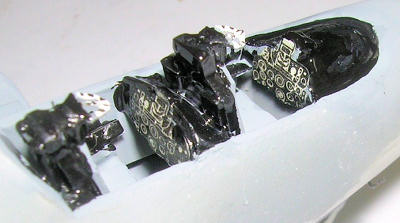 configuration
and also the crew figures give a much needed scale impression to the completed
model. Ejection made from thin plastic bent to shape added to top of seats. The
instruments that came from Model Decal sheet were added later before closing the
cockpit canopy.
configuration
and also the crew figures give a much needed scale impression to the completed
model. Ejection made from thin plastic bent to shape added to top of seats. The
instruments that came from Model Decal sheet were added later before closing the
cockpit canopy.
A major modification to the
fuselage to bring it to S.Mk1 standard was shortening the engine nacelle so that
the distance between the wing trail edge and end of engine exhaust pipe is
reduced to conform to scale plans I was referring to. This was removing some
3/8” from the engine pipe at each side. A triangular piece was shaped and fitted
at the rear of exhausts and the rest was shaped using Plasto filler. Interior
engine pipes
were
added with cut lengths from ballpoint plastic tubes. There was one for each side
which was blanked at the inside end. Another pair of pipes that were shorter were
added to the air intakes, which also needed opening the aperture a little
Other alteration was made to the
tailfin area where fore and aft bullets shaped fairings were added to upper tail
fin. An air intake added to the
leading edge of tail. Other smaller detail items added to the model were: red
beacon light on upper fuselage,, fairing under nose area, landing light to nose
gear, refuelling probe made from shaped stretch sprue, two antennae under nose
area and two in tandem antennae
above fuselage. Small fairing detail to bay door and finally added 4x pylons
under the wings while the leading edges had two
| COLORS & MARKINGS |
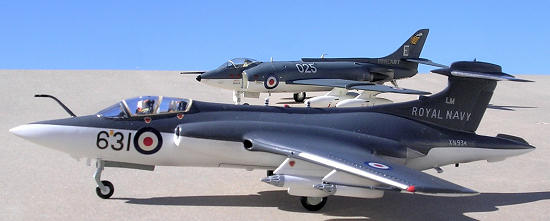
| CONCLUSIONS |
February 2012
If you would like your product reviewed fairly and fairly quickly, please contact the editor or see other details in the Note to Contributors.